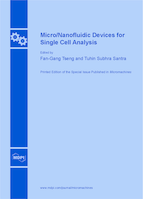Micro/Nanofluidic Devices for Single Cell Analysis
A special issue of Micromachines (ISSN 2072-666X).
Deadline for manuscript submissions: closed (31 July 2013) | Viewed by 97661
Special Issue Editors
Interests: organ on a chip; microfluidic systems; biosensors; CTCs/CTM diagnosis; single cell analysis
Special Issues, Collections and Topics in MDPI journals
Interests: MEMS; Bio-NEMS; single- cell technology; biomedical micro/nano devices; micro/nanofluidics; nanomedicine
Special Issues, Collections and Topics in MDPI journals
Special Issue Information
Dear Colleagues,
Cells are the most fundamental building blocks for most of life forms, and always play a significant role in coordinating with one another to perform systematic functions in living creatures. However the behaviors of cell to cell or cell to the environment with their organelles and their intracellular physical/biochemical/biological effects are still unknown. To insight this interaction, ensemble measurement for millions of cells together cannot provide the proper information, such as stem cell proliferation and differentiation, neural network coordination, and cardiomyocytes synchronization. Thus single cells analysis has come into frontier research since last few decades. To analyze the cellular function, single cells analysis (SCA) can be conducted by employing miniaturized devices, whose dimension is similar to that of single cells. Micro/nanofludic device with the power to manipulate and detect biosamples, reagents, or biomolecules in micro/nano scale can well fulfill this requirement for single cells analysis. The analysis can be performed by combining capillary electrophoresis (CE) with laser induced fluorescence (LIF) detection methods, electrochemical detection (ED), flow cytometry, mass spectrometer etc. However this powerful technology can provide specific information about cell interactions with high spatial and temporal resolution. Micro-nanofludic device is not only useful for cell manipulation, cell lysis, cell separation but also it can easily control biochemical, electrical, mechanical parameters for SCA analysis. This special issue will invite manuscripts conducting researches on integrated micro or nano systems dealing with single cell manipulation, injection, separation, lysis of single cell, dynamics of single cell with the use of micro/nanofluidic devices combined with various detection schemes. The role of single cell analysis is recognized as one of the important pathways for system biology, proteomics, genomics, metabolomics and fluxomics and potentially leads to paradigm shift. The discussion of application of single cell analysis for biocatalysis, metabolic, bioprocess engineering and the future challenge for single cell analysis with their advantages and limitations are also welcome to be included in the manuscripts.
Dr. Tuhin Subhra Santra
Assistant Guest Editor
Prof. Dr. Fan-Gang Tseng
Guest Editor
Manuscript Submission Information
Manuscripts should be submitted online at www.mdpi.com by registering and logging in to this website. Once you are registered, click here to go to the submission form. Manuscripts can be submitted until the deadline. All submissions that pass pre-check are peer-reviewed. Accepted papers will be published continuously in the journal (as soon as accepted) and will be listed together on the special issue website. Research articles, review articles as well as short communications are invited. For planned papers, a title and short abstract (about 100 words) can be sent to the Editorial Office for announcement on this website.
Submitted manuscripts should not have been published previously, nor be under consideration for publication elsewhere (except conference proceedings papers). All manuscripts are thoroughly refereed through a single-blind peer-review process. A guide for authors and other relevant information for submission of manuscripts is available on the Instructions for Authors page. Micromachines is an international peer-reviewed open access monthly journal published by MDPI.
Please visit the Instructions for Authors page before submitting a manuscript. The Article Processing Charge (APC) for publication in this open access journal is 2600 CHF (Swiss Francs). Submitted papers should be well formatted and use good English. Authors may use MDPI's English editing service prior to publication or during author revisions.
Keywords
- lab on a Chip
- life on a Chip
- organ on a chip
- lab in a Cell
- cell chip
- micro total analysis (µTAS)
- microfluidics
- nanofluidics
- single-cell perturbation
- single-cell cultivation
- single cell proteomics
- single cells interaction
- dielectrophoresis
- electrophoresis
- optical Trapping
- capillary electrophoresis
- electroporation
- flow cytometry
- heterogeneity
- mechanical characterization
- optical characterization
- biochemical characterization
- system biology








